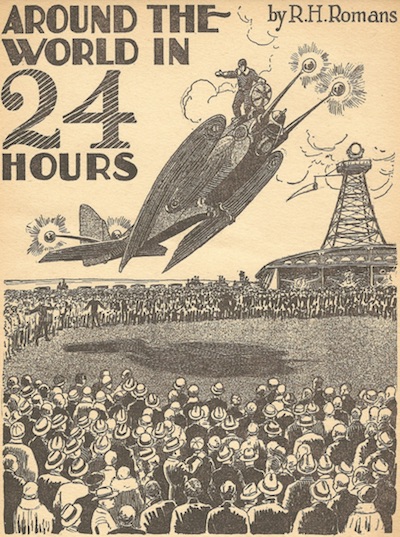Science Fiction
Dictionary
A B C D E F G H I J K L M N O P Q R S T U V W X Y Z
Pivotal Blackfly Electric Aircraft Lifts And Hovers

The Blackfly ultralight eVTOL looks like pure fun.
The BlackFly was designed for the FAA’s Part 103 Ultralight category, which requires no formal flight training, but stipulates a maximum dry weight of 254 lbs. (the BlackFly’s ballistic parachute and flotation bring total weight to 348 lbs.), and pilots can’t exceed 220 lbs. Ultralights are restricted to a top speed of 55 knots (63.3 mph), and flying over populated areas is strictly forbidden.(Via RobbReport.)
I was strongly reminded of a daring idea from almost one hundred years ago. In his 1929 story Around the World in 24 Hours, R.H. Romans wrote about an amazing electric plane that could not only fly as a traditional plane, but could hover in place:

(Around the World in 24 Hours)
The weight of the car is regulated by the same method. The small spheres under the car produce a high pressure area while others above produce a low. When the proper electrical current passes through the spheres, the upward pressure against the car is exactly balanced by the force of gravity acting on the car, which becomes apparently weightless. But the wind would blow the weightless car away if other precautions were not taken. The rudder now acts as a weather vane and the nose of the ship is pointed windward. The ship is pointed toward the wind with a velocity exactly equal to that of the wind itself. I still have one hand on the control knob and as the velocity of the wind is seldom constant, I find it necessary to increase or decrease the power."That explains how it was so easy for me to remain motionless in midair or to perch on a flagpole in imitation of a giant bird, even in the windy city of Chicago."
(Read more about the Atmospheric Pressure Control Plane)
Thanks to @SFFaudio for the tip on this story.
Scroll down for more stories in the same category. (Story submitted 3/29/2025)
Follow this kind of news @Technovelgy.| Email | RSS | Blog It | Stumble | del.icio.us | Digg | Reddit |
Would
you like to contribute a story tip?
It's easy:
Get the URL of the story, and the related sf author, and add
it here.
Comment/Join discussion ( 0 )
Related News Stories - (" Engineering ")
Did The Yautja Have These First?
What a marvel of ingenuity the little device was! - Harry Bates, 1934.
Jetson ONE Air Races Begin, Can Air Polo Be Far Behind?
'If you're one of those rarities who haven't attended a rocket-polo "carnage", let me tell you it's a colorful affair.' - John Victor Peterson, 1938.
X-Control Janus-1 A Suitcase Aircraft
'You will notice that it... fits the suitcase nicely.' - E.D. Skinner, 1929.
Time Crystals Can Now Be Seen Directly
'It is as you thought when you constructed the time crystal, my master Vaylan.' - NK Heming, 1952.
Technovelgy (that's tech-novel-gee!) is devoted to the creative science inventions and ideas of sf authors. Look for the Invention Category that interests you, the Glossary, the Invention Timeline, or see what's New.
Science Fiction
Timeline
1600-1899
1900-1939
1940's 1950's
1960's 1970's
1980's 1990's
2000's 2010's
Current News
iPhone Air Fulfils Jobs' Promise From 2007 - A Giant Screen!
'... oblongs were all over the floor and surfaces.'
ChatGPT Now Participates in Group Chats
'...the city was their laboratory in human psychology.'
iPhone Pocket All Sold Out!
'A long, strong, slender net...'
Did The Yautja Have These First?
What a marvel of ingenuity the little device was!
Jetson ONE Air Races Begin, Can Air Polo Be Far Behind?
'If you're one of those rarities who haven't attended a rocket-polo "carnage", let me tell you it's a colorful affair.'
Will Space Stations Have Large Interior Spaces Again?
'They filed clumsily into the battleroom, like children in a swimming pool for the first time, clinging to the handholds along the side.'
Mornine Sales Robot
'Robot-salesmen were everywhere, gesturing...'
Bipedal Robot Floats Gently While Walking
'a walking balloon proceeded with long strides of its aluminum legs...'
Musk Idea Of Cars Talking To Each Other Predicted 70 Years Ago
'My cars talk to one another.'
Elegant Bivouac Shelter Produces Water And Electricity
'There was nowhere on the planet where science and technology could not provide one with a comfortable home...'
X-Control Janus-1 A Suitcase Aircraft
'You will notice that it... fits the suitcase nicely.'
'AI Assistants' Are Actually Less Reliable For News
'Most men updated their PIP on New Year's Day...'
YES!! Remote Teleoperated Robots predicted by Technovelgy!
'...a misshapen, many-tentacled thing about twice the size of a man.'
Will Robots Ever Fold Landry?
Where have you gone, Mrs. Robinson?
Will AIs Give Better Results If You're Rude To Them?
'I said, "Listen up, motherf*cker.'
Cybertruck Robotic Arm F10 Drone Launch!
Drone away!
